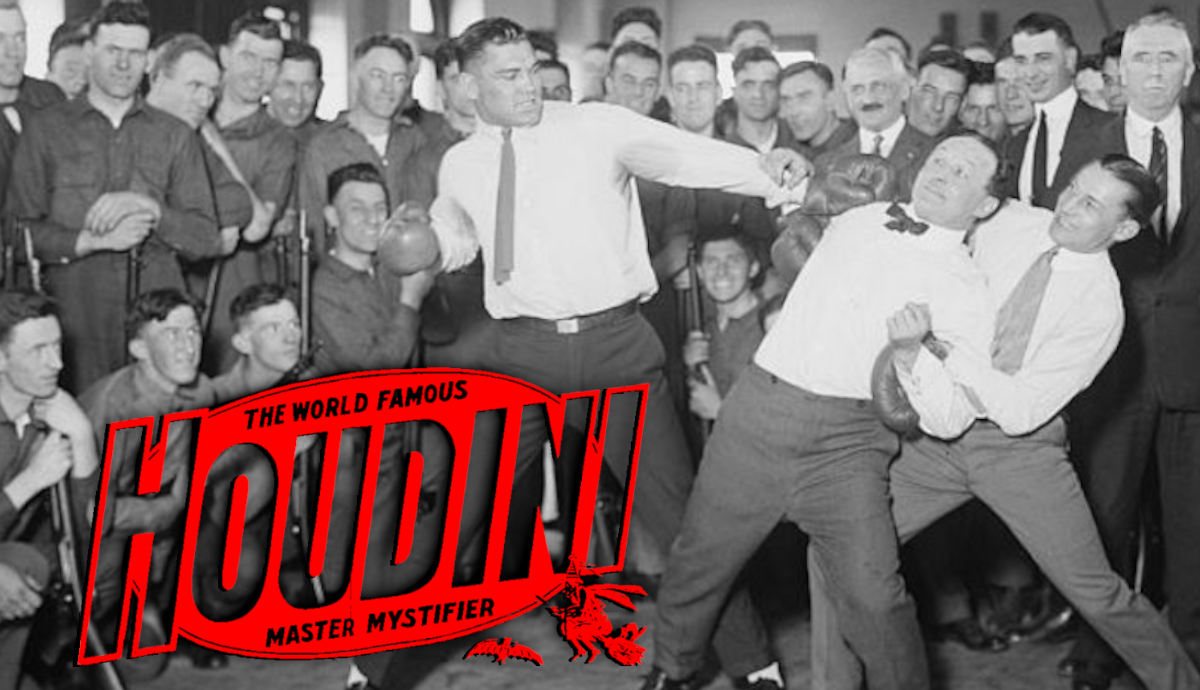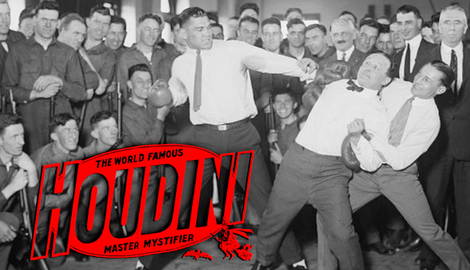
Harry Houdini was one of the most popular vaudeville acts of the early 20th century. He toured all over, showing off his uncanny ability to escape any trap that ensnared him. Houdini was also a vehement dissenter of the popular Spiritualist movement and spent nearly as much time railing against the practice as he did performing in the 1920s. When Houdini died under mysterious circumstances, the nature of his demise came into question. What happened to Harry Houdini, and what are the rumors about his untimely death?
Who Was Harry Houdini?

Harry Houdini was born Ehrich Weisz in Budapest, Hungary, on March 24, 1874. Erik and his parents immigrated to the United States when he was four years old and settled in Appleton, Wisconsin. Weisz’s father served as the community’s Reform Jewish Congregation as their rabbi, and the family changed their name to Weiss, the German spelling of the name. Ehrich also became Erik, a child who would prove to be very different from his six siblings.
The Weiss children had to work from a very young age to help support their family. This culminated in Erik joining a local circus, where he was dubbed “Ehrich, The Prince of Air.” When the Weiss family moved to New York after a long bout of struggle in the Midwest, Erik started playing sports and practicing magic for fun. His natural athleticism, paired with his desire to do magic tricks, would ultimately lead to his big break.
After performing in small-time theaters with a friend and then his brother, Weiss married Wilhemina Beatrice Rahner, who became his assistant. The two brothers, along with Erik’s wife, became “The Houdinis,” a name styled after the famous French magician Jean-Eugène Robert-Houdin, of whom Erik was always an admirer.

After renaming himself Harry Houdini and continuing to tour with his wife and brother, Houdini’s big break came in 1899 when vaudeville tycoon Martin Beck took notice of the magician’s shows and set him touring all over the country. Houdini’s main trick was his ability to escape from any restraint he was placed in, whether this be a policeman’s handcuffs, a federal prison, or a tank of water.
Houdini was called “The Handcuff King” and baffled audiences all over the globe, quickly gaining him massive fame and notoriety as one of the world’s best escape artists. He continued diversifying his acts, coming up with new tricks, and remaining one of the most famous people to ever come out of the vaudeville circuit.

Houdini was wary of the possibility of waning popularity but was unhappy to coast on his previous earnings into retirement. Instead, he began filming his tricks, eventually owning his own movie production company. In the 1920s, Houdini amassed one of the world’s largest collections in the history of magic. In doing so, he also came into contact with the world of Spiritualism and became vehement in exposing the famous mediums and psychics for what they were: performers.
This fervor took on a life of its own, and Houdini conducted several exposes of popular mediums in the wake of World War I. He became Public Enemy No. 1 to the Spiritualist movement, as he was so convinced that these mediums were defrauding the people they claimed to help. He went so far as to begin including a Spiritualist exposé in his shows, including his one-man Broadway show titled “HOUDINI.”
The Events Before Houdini’s Death

Harry Houdini’s one-man show was wildly popular. After taking the show on tour, he sold out concert halls and theaters throughout the United States, as he had been doing for almost three decades when the dawn of 1926 came. At the age of 52, Houdini was still as hardworking as he had ever been and would not give up performing for hardly anything, including his safety.
Houdini’s tour was a series of unfortunate events, the show’s success notwithstanding. His wife had been ill with food poisoning, and Houdini himself had broken a bone in his ankle while attempting a particularly difficult trick. However, the show went on for the famed illusionist, and he never stopped to take a break or, for that matter, see a doctor.
Houdini had railed against the Spiritualist movement in Congress that year to ban fortune telling in the United States. It was clear that he had angered the Spiritualists, and instead of any public acquiescence, Houdini doubled down on his position. It was in Montréal at McGill University that the events that would lead to the death of the great magician began to transpire.

After finishing a lecture at the university on the harmful effects of Spiritualism, Houdini was in his dressing room at the Princess Theatre preparing for his next leg of the tour when he met with a group of McGill medical students who were fans of his. After talking for a while about his show, one student, J. Gordon Whitehead, aimed to test the theory of Houdini’s supposedly great strength. Houdini was known for being able to withstand physical beatings due to his muscular physique; particularly, he was able to withstand several punches to the abdomen without being hurt.
When Whitehead caught Houdini off-guard and punched him in the gut several times, however, the magician had not been able to brace himself. The punches hurt unusually badly for Houdini. Though he performed as usual that night, he complained of stomach cramps and discomfort. By the next day, Houdini was in severe abdominal pain and had a fever of 102 degrees Fahrenheit.
Though Houdini was uncomfortable, he chalked it up to his broken ankle and soreness from the punches and still boarded his 15-hour train to Detroit, Michigan. Unbeknownst to him, Houdini would perform his last show in Detroit.
Houdini’s Death

While in his dressing room at the Garrick Theater in Detroit, Houdini was seen by a local doctor, who suspected that acute appendicitis was to blame for the abdominal pain rather than the punches. The doctor recommended that Houdini go to the hospital at once, but the magician refused, ever the proponent of the adage “the show must go on.”
The show did go on, albeit in a haphazard fashion. Houdini’s temperature had risen to 104 degrees, and he relied heavily on his assistants to help with his two-and-a-half-hour show. Audience members reported that Houdini seemed to be rushing through his tricks, and by the middle of the third act, Houdini had to give up. As soon as the curtain was lowered, the famed magician collapsed where he stood.
Despite collapsing and having to be carried back to his dressing room, Houdini still refused medical care until the morning, when his wife, Bess, insisted that he go to the hospital. By this time, it had been three full days since the punch, and the pain had only worsened. Houdini had no choice at the hospital but to agree to an operation.
However, by the time doctors got him into surgery, Houdini’s appendix had ruptured, allowing periodontitis to develop and essentially poison the magician’s abdominal cavity. Before antibiotic treatments, this condition was a death sentence. Houdini held onto life for six days after his operation but eventually succumbed to sepsis at the age of 52 on October 31, 1926, with his wife and brother at his bedside.
The Aftermath of Houdini’s Death

Doctors listed Houdini’s death as periodontitis caused by a burst appendix. At the time, it was accepted that the punch Houdini took to the gut caused his appendicitis and, indirectly, his death. Bess, Houdini’s wife, was even awarded double the original value of Houdini’s life insurance policy due to his accidental death.
Houdini was buried on November 4, 1926, in Queens, New York. His death attracted attention from all over the world, but not all of the attention was positive, and not everyone mourned the magician. After learning that Houdini died on Halloween, the Spiritualist movement quickly claimed responsibility for his death. Leagues of exposed fraudulent mediums hated Houdini, and he had been threatened with death and physical harm by Spiritualists before.
Spiritualists were not above murder and had poisoned enemies in the past, according to authors of The Secret Life of Houdini William Kalush and Larry Sloman. In addition to his enemies’ apparent penchant for violence, Kalush and Sloman also point out that an autopsy was never carried out on the body of Houdini, claiming that it was plausible that someone could have poisoned him quite easily without ever being caught.

Don Bell, the author of The Man Who Killed Houdini, asserts that the medical student who punched Houdini, J. Gordon Whitehead, could have been an agent of the Spiritualists or that when he punched Houdini, an angry spirit could have reinforced the blow to one that would kill.
Despite the conspiracy theories and even medical professionals’ beliefs that the punch caused his death, it is most likely that Houdini simply died as a result of his stubbornness. Modern scholars believe that Houdini was likely already suffering from appendicitis when Whitehead punched him, exacerbating the condition.
The punch, thus, was not causal but coincidental. It probably worsened the condition, but what killed Houdini was not the punch. Rather, Houdini died, most likely, as a result of his delay in medical care and his bullishness in finishing his shows. If he had sought care before the pain and fever worsened, likely, the appendix would not have ruptured, and Houdini would have lived.
Houdini From Beyond the Grave

Despite his hatred for fraudulent mediums, Houdini never gave up in his quest to find just one Spiritualist who was not a phony. Before he died, Houdini told his wife to hold seances, and if she ever received a certain word, she would know that the medium was real.
Bess was the only person to know the codeword her husband gave her, and she held seances for a decade on the anniversary of Houdini’s death. Year after year, she never received word from any mediums, leading her to believe that Houdini was right, that mediums would give her no comfort or solace.
Though Bess discontinued her annual seance in 1936, to this day, people conduct seances at Houdini’s gravesite every November, searching for his lost spirit. He has never materialized, and in his lack of presence, it seems he proved his point against psychic mediums.










